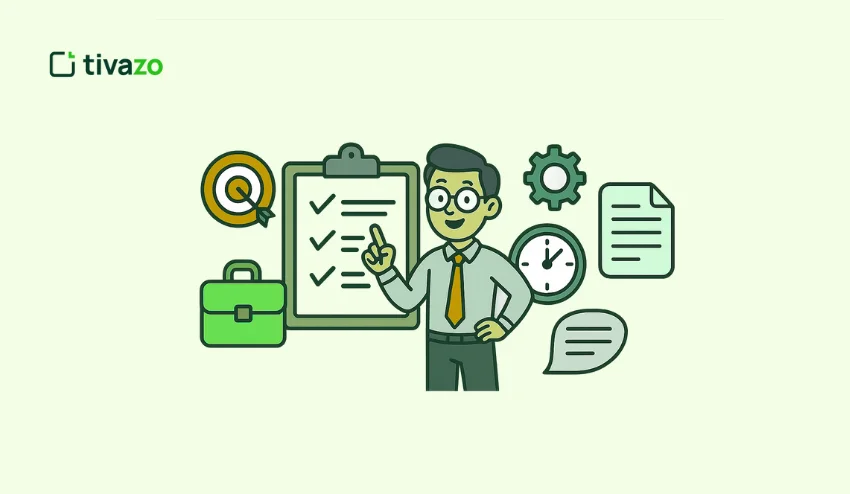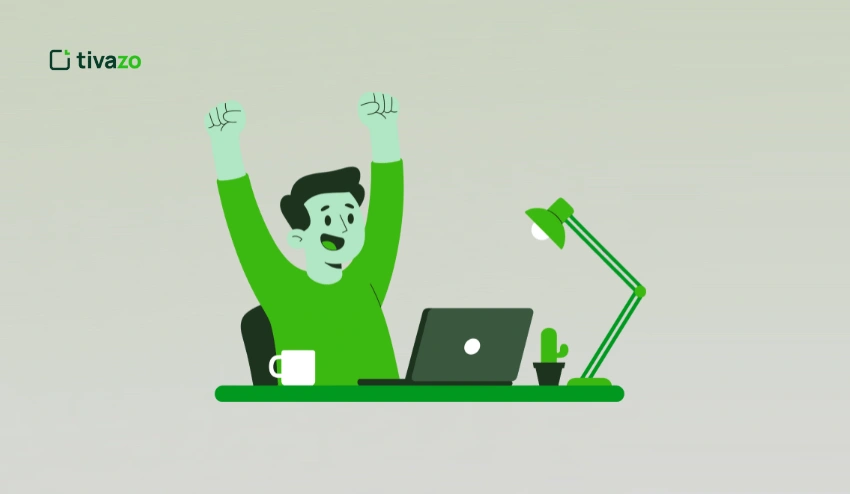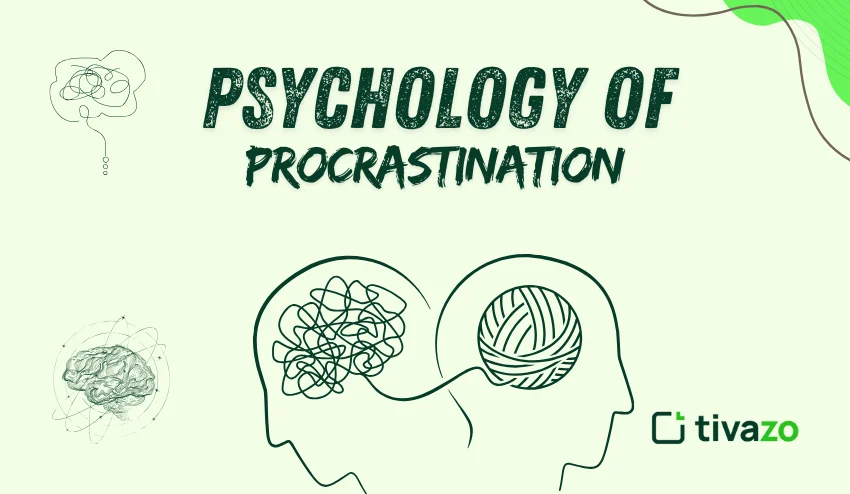Did you know that unconscious bias affects 95% of people? That is to say that nearly everyone you deal with has hidden biases of which they are not even aware.
Such biases are invisible and influence our hiring, promotion, and interactions with colleagues in our day-to-day activities. They provide undue advantage to certain employees as well as barring others. The result? Talented individuals are ignored, organizations lose diversity in their teams and fail to get superior ideas and innovation.
The good news is, however, that unconscious bias in the workplace is not here to stay. Having known what it is and how it works, you can then make tangible efforts to mitigate its effects. This guide will not only demonstrate how to be aware of bias both in yourself and your work environment, but also seven strategies that have been proven to be effective.
Are you willing to make the workplace more equitable and inclusive? Let’s dive in.
What Is Unconscious Bias in the Workplace?
Core Definition
Unconscious bias in the workplace refers to automatic preferences and judgments that influence your decisions about colleagues without you realizing it. These are mental shortcuts that occur immediately, and are based on the stereotypes that your brain has acquired over time.
Unconscious bias can be thought of as your autopilot mode. These biases operate in the background just like you do not think of breathing consciously. They influence whom you believe, whom you hear and whom you believe should be given opportunities.
How It Differs from Conscious Bias
Intentional discrimination is conscious bias. An individual will intentionally mistreat other people due to their race, gender, age, and other forms. This form of discrimination is quite apparent and tends to be against policies.
Unconscious bias is far more complicated. It occurs unconsciously, without your knowledge or will. You might actually be of the opinion that you believe in equality when you make biased decisions. To illustrate, you might subconsciously think that the silent woman in the meetings has less to say, despite the fact that you are a conscious supporter of gender equality.
The key difference? Conscious bias is a willful decision. Unconscious bias is an aspect of mental shortcuts that ignore your rational thinking.
Real Workplace Examples
Here are common ways unconscious bias shows up at work:
- In the recruitment process: It is automatic favoritism to hire people who attended the same university as you even when other applicants are equally qualified.
- During meetings: Interrupting female colleagues on a regular basis and allowing male colleagues to complete their thoughts.
- In the case of promotions: It is assumed that younger workers are not fit to be leaders, no matter how they perform and what their competencies are.
- Team assignments: Assigning high-visibility projects to individuals who remind you of yourself instead of assigning opportunities equally.
These illustrations demonstrate that bias may insidiously enter daily workplace choices, and nobody may detect it.
Unconscious Bias vs. Microaggressions: What’s the Difference?
Many people confuse unconscious bias in the workplace with microaggressions, but they’re actually different concepts that often work together in professional settings.
Unconscious bias in the workplace is the mental process happening in your mind. It is the unconscious kind of preference or stereotype that affects your thinking regarding colleagues, candidates or business choices. You need not even notice it is there.
Microaggression refers to the behaviors or statements which are caused by unconscious bias. They are tiny, sometimes even unspoken actions that convey prejudice to other people. Microaggressions are observable and felt by the individuals surrounding you unlike the prejudice itself.
Consider it in the following way: the thought is unconscious bias, and the action is microaggression.
Here’s how they’re connected in real workplace situations:
- The bias: The unconscious attitude to older workers as less tech-savvy.
The microaggression: You explain simple computer procedures to your 55-year-old colleague, despite the fact that he/she is very adept at technology. - The bias: The assumption that individuals who have foreign-sounding names are less qualified.
The microaggression: It is always pronounced wrong by a colleague, even though his name is pronounced incorrectly. - The bias: Women are naturally superior when it comes to administrative duties.
The microaggression: Asking female team members to take meeting notes, or to take notes in general, even when it is not their responsibility.
It is important to understand this relationship. Although you can not always stop your unconscious biases at the moment, you can be taught to be aware of them and prevent the microaggressions they cause. Such awareness will end the cycle and minimize the damage to your colleagues.
How Does Unconscious Bias in the Workplace Affect Employees and Organizations?
Unconscious bias in the workplace doesn’t just hurt feelings. It causes actual, quantifiable hurt that impacts on individual employees and whole organizations. We can deconstruct these effects to see why working on unconscious bias in the workplace should be a priority.
Impact on Individual Employees
When unconscious bias in the workplace goes unchecked, employees face serious consequences that affect their careers and wellbeing.
- The barrier to career advancement is the most evident issue. Promotions are given to the wrong employees since the decision-makers have an unconscious preference of individuals who resemble them in physical appearance or thought patterns. Studies indicate that women and minorities are forced to perform much better than their counterparts in order to be given the same level of recognition.
- Job satisfaction and engagement suffer a significant blow. When employees feel that they are being undervalued, they wonder whether their input is important. They begin to lose interest in team projects, talk less in meetings, and become unmotivated to do more.
- The mental health and well-being are devastated. The presence of unconscious bias on a regular basis causes chronic stress and anxiety. The employees consume mind power by wondering whether they are being judged fairly or whether they have to work harder to prove themselves.
Organizational Consequences
The ripple effects of unconscious bias in the workplace extend far beyond individual employees, creating significant organizational problems.
- Less diversity and innovation are bound to happen. When bias is used to hire and promote employees, organizations create homogeneous groups of employees who think in a similar manner. This deficiency in different views creates group thinking, lost opportunities, and non-diversified solutions to different customer groups.
- Increased turnover expenses are a waste in the company. Workers who are discriminated against tend to quit to join firms where they can feel appreciated and honored. Recruitment, training, and loss of productivity make the cost of replacing an employee between 50 and 200 percent of annual salary.
- There are threats of legal risks and reputation damage. Discrimination lawsuits, regulatory inquiries, and bad publicity can be the results of workplace bias. Nowadays, in the environment of social media, any act of bias can spread rapidly, harming your employer’s brand.
- The effect of financial performance is reflected in the bottom line. Those companies that have more diverse leadership teams always outcompete their rivals in terms of finances. Companies that do not tackle unconscious bias are unable to enjoy this competitive edge and might find it hard to stay afloat in a variety of markets.
How to Recognize Unconscious Bias in Yourself
The first step to reducing unconscious bias in the workplace is recognizing when you have it. These biases work under your conscious mind so to detect them you require certain strategies.
Warning Signs You Have Unconscious Bias
Your biases are unconscious, and they tend to manifest themselves in subtle patterns of your behavior and decision-making. Watch for these red flags:
- There are some kind of people you always relate with. There is a natural inclination to work with people that have a similar background, interests, or communication style.
- Your initial impressions are out of the ordinary strong. You like or dislike someone at the very least of interaction.
- You are quick to judge the capabilities of people. You just automatically think that a person is or is not qualified because of his or her appearance and age, or accent.
- You are shocked when people do not act as per the stereotype. You are surprised to find that the silent individual has really good ideas or the young worker is a leader.
- There is a huge difference in your feedbacks with similar performance. You criticize some employees more severely and treat other employees more leniently when they do the same mistakes.
Simple Self-Assessment Questions
AThese are questions that you should ask yourself frequently in order to recognize unconscious bias in your interactions at the workplace:
- Which participants do I most often interrupt during meetings, and which do I allow to finish their thoughts?
- When people consider the possibility of becoming a leader, what kind of a person do they think of first?
- Do I provide team members with an equal quality of feedback and development opportunities?
- Which are the colleagues that I invite to an informal conversation or networking event?
- Am I more likely to blame success to skill or luck based on the person who has done it?
- Do I have different expectations of professionalism depending on the background or looks of a person?
Daily Reflection Techniques
Building awareness of unconscious bias in the workplace is a matter of practice. Try these daily techniques:
- The pause technique: Pause before making crucial decisions regarding people, take a 10-second break. Ask yourself what assumptions you may be making and whether they are evidence based or stereotypical.
- The flip test: When assessing a person, consider that he/she had other features (different gender, race, age, etc.). And would you come to the same conclusion? Otherwise, you may be subject to bias.
- Review at the end of the day: Take five minutes every evening to reflect on your interactions in the workplace. Did you respect and attend to everyone equally? Was there a point at which prejudice could have entered?
- The practice of documentation: Make short notes on your choice about people. After several weeks, have them reviewed to patterns. Do you always prefer some types of people?
These self-awareness techniques help you catch unconscious bias in the workplace before it affects your actions and decisions.
8 Most Common Types of Unconscious Bias at Work
Understanding the different types of unconscious bias in the workplace helps you recognize them when they occur. Here are the eight most common forms of unconscious bias in the workplace that affect decisions and interactions.
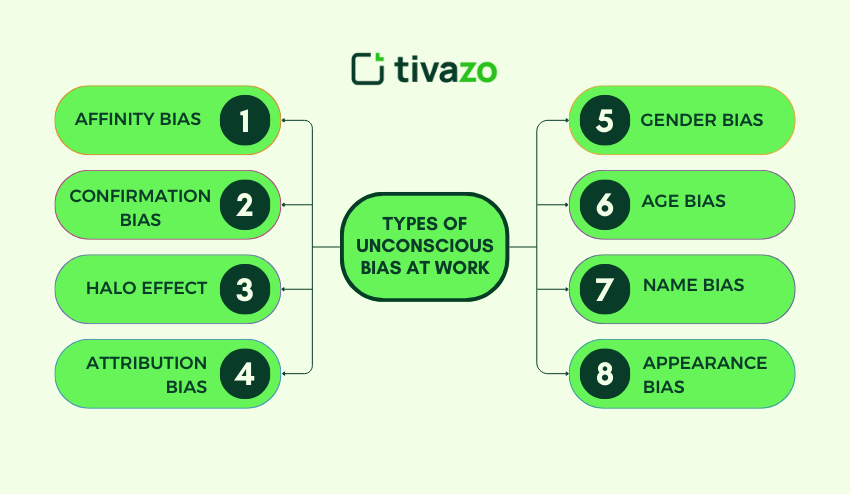
1. Affinity Bias
You like individuals that are similar to you in terms of background, interests or experiences. This type of unconscious bias in the workplace leads to hiring and promoting people who remind you of yourself rather than the most qualified candidates.
2. Confirmation Bias
You are searching something that will affirm your already held beliefs about someone. When you believe that a person is a bad performer, you see the errors he or she makes more than the positive things.
3. Halo Effect
A good characteristic affects how you will judge a person. An individual who attended a good university is perceived as someone who is qualified in everything even without being proved.
4. Attribution Bias
Depending on what you have preconceived people act differently. When a man talks assertively, he is perceived as being confident. When a woman does the same, she is considered to be aggressive.
5. Gender Bias
You make gender-related assumptions with regards to abilities or roles. Women are given administrative duties irrespective of their rank. Technical positions are automatically offered to men.
6. Age Bias
You are assessing the abilities of people according to their age. The assumption is that older workers are less technological. Employees who are young are considered to be inexperienced or immature.
7. Name Bias
You make judgments about the qualifications of a person basing on his or her name. Resumes that contain a foreign-sounding name attract fewer calls in comparison with the same resumes with traditional Western names.
8. Appearance Bias
You consider people differently depending on their physical appearance. Those employees who fit the traditional definition of professionalism receive more opportunities and better treatment.
All these biases may have a major influence on workplace decisions, including hiring and promotions, as well as everyday communication and project placement. Recognizing these patterns is the first step toward reducing unconscious bias in the workplace and building more inclusive professional relationships.
7 Strategies to Reduce Unconscious Bias
Now that you understand what unconscious bias in the workplace looks like, here are seven evidence-based strategies that actually work to reduce its impact.
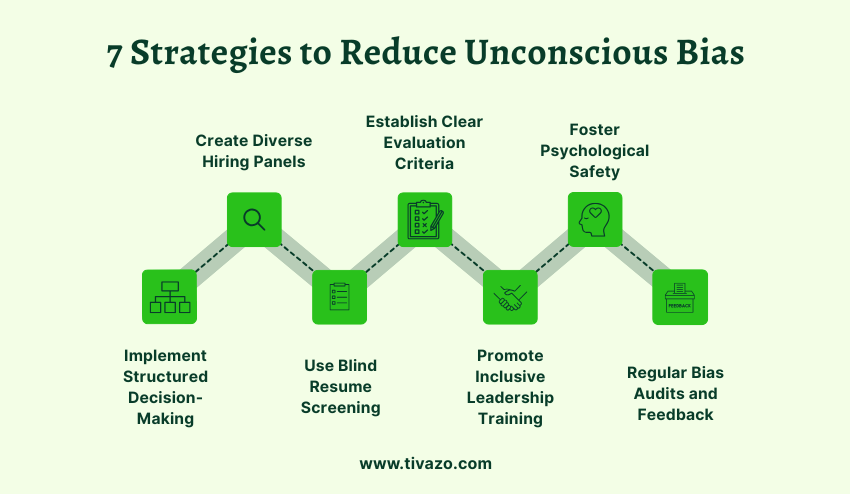
Strategy 1: Implement Structured Decision-Making
Instead of using gut-feeling to make hiring, promotions, and evaluations, use standardized criteria. Apply scorecards of certain qualifications and justify your decision. Such openness can be used to find out when bias is at work.
Strategy 2: Create Diverse Hiring Panels
Constitute interview panels of individuals of various backgrounds and departments. There are several points of view that can be used to overcome personal prejudices. Train panel members to be aware of unconscious bias and make decisions by agreement.
Strategy 3: Use Blind Resume Screening
Eliminate names, photographs, addresses and university details in the first screening. Concentrate on skills and experience. This directly touches on name bias, age bias and appearance-made assumptions.
Strategy 4: Establish Clear Evaluation Criteria
Before assessing individuals, determine measures of success. Develop performance review and leadership potential specific, measurable criteria. Post these standards to employees to have a clear understanding of expectations.
Strategy 5: Promote Inclusive Leadership Training
Train managers to recognize and interrupt unconscious bias in the workplace. Pay attention to such practical skills as inclusive communication and equitable performance management. Training should be continuous and not a single event.
Strategy 6: Foster Psychological Safety
Establish the culture of having individuals report any bias without fear. Promote the discussion of alternative points of view. The leaders are expected to be exemplary with regard to inclusive behavior and to acknowledge their own biases.
Strategy 7: Regular Bias Audits and Feedback
Examine data at the workplace in terms of bias during hiring, promotions, and salary allocations. There should be anonymous surveys on fairness and inclusion. Apply this information to solve problem areas.
These are strategies that should be used in combination. Begin with a single or two methods and build up on them as they become part of your culture.
5 Common Mistakes to Avoid When Addressing Bias
Even with the best intentions of trying to minimize unconscious bias in the workplace, these attempts may backfire when you commit the following pitfalls. Here’s what to avoid:
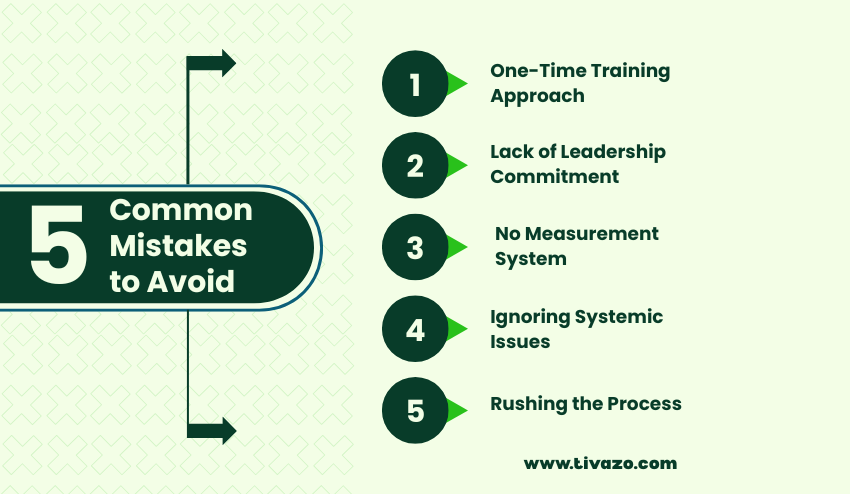
1. One-Time Training Approach
Mistake: Believing that one diversity training will eliminate the problem of unconscious bias.
Why it does not work: The bias is deeply rooted and needs constant reaffirmation to transform. A single session generates awareness but does not develop long-term skills.
More appropriate solution: Conduct frequent training and microlearning courses and reinforcement through daily practice.
2. Lack of Leadership Commitment
Mistake: Leaving bias programs to the HR without leadership.
Why it does not work: Leadership behavior is modeled by the employees. Without the active involvement of the leaders, the effort will not be credible and effective.
Better solution: Publicly lead executives through the initiatives, talk about their own experiences of bias, and hold themselves responsible.
3. No Measurement System
Mistake: The adoption of strategies without monitoring outcomes or feedback.
Why it won’t work: You cannot measure what you cannot measure. You will not be able to tell whether your efforts are bearing fruits or where to target next without having the data.
More effective solution: Have baseline measures in place, perform frequent surveys, and examine the data on hiring and promotions to identify trends of bias.
4. Ignoring Systemic Issues
Mistake: Giving attention to the individual awareness and disregarding organizational policies and process.
Why it does not work: Individual consciousness will never break biased systems, structures, and procedures to promote unfairness.
Better solution: Have your policies, job descriptions, performance review processes, and organizational structures audited to be biased.
5. Rushing the Process
Mistake: Thinking that culture change will happen instantly or attempting to apply all the strategies simultaneously.
Why it does not work: Sustainable change is a lengthy process. Hurrying causes congestion and opposition, which end up sabotaging your work.
More appropriate solution: Have a step-by-step systematic solution. Give time to all the strategies before introducing new initiatives.
By avoiding these pitfalls, you will be able to make sure that your unconscious bias in the workplace programs produce long-term and significant change as opposed to short-term awareness.
Conclusion
Unconscious bias in the workplace may be invisible, but its effects are powerful and far-reaching. The expenses are too high to overlook, as they are not only restricting the growth of employees but also slowing down innovation and the overall performance of the organization. The positive thing is that, as soon as you become aware of the working principle of bias, you will be able to interrupt this process.
With the implementation of the structured decision-making process, the encouragement of inclusive leadership, and the promotion of the culture of accountability, organizations can establish the environment in which talent can be cultivated on merit, rather than on the basis of the concealed stereotypes. It will not be an overnight process, but the small steps that are made regularly will go a long way in the long run.
Finally, fairness is not the only reason to deal with unconscious bias, but to create stronger, more diverse, and more resilient workplaces where everybody has the opportunity to achieve success. Now the question is: are you willing to make the next step towards a more inclusive workplace?

